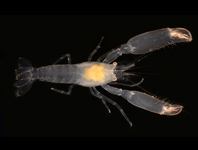Abstract
We updated a previous database that compiled all the information available in 2010 for the species distribution of spiders (Araneae) in the Iberian Peninsula, Balearic Islands (Illes Balears) included. By the end of 2018 a total of 30834 records were compiled. These belong to 1493 species, 282 of those endemic to the peninsula, across 56 families and 402 genera. This represents an increase of approximately 14% in the number of species in the last nine years. From all families found in the Iberian Peninsula, Araneidae represent the highest number of records (3315), Linyphiidae the highest species richness (302) and Dysderidae the highest endemic richness (58). When considering only the 2010 decade, Linyphiidae lead in both number of records (1417) and species (49), but Gnaphosidae have the highest newly described endemic richness (18). When looking at the full data per province, the largest number of records are located in Illes Balears (1864), followed by Barcelona (1287). When it comes to species, Huesca (474) and Barcelona (470) are the richest provinces. However, it is Illes Balears that possesses the largest known endemic richness (43), followed by Beja and Faro (39). Regarding the last decade, Illes Balears received the largest sampling effort with 901 records, followed by Girona (806). Ciudad Real had the highest increase in known richness with 191 new species to the province, followed by León and Lleida (188). The most new endemic species were found in Faro (16), followed by Almería and Cádiz (13). This checklist is accompanied by an online catalogue where all its information is fully listed.
References
Barea-Azcón, J.M., Ballesteros-Duperón, E. & Moreno, D. (Eds.) (2008) Libro Rojo de los Invertebrados de Andalucía. Consejería de Medio Ambiente, Junta de Andalucía, Sevilla, 1298 pp. Available from: http://www2.ceab.csic.es/maldonado/2008_Lampreave-et-al-_BookChapter.pdf (accessed 14 May 2019)
Barrientos, J. & Febrer, B. (2017) Arañas (Arachnida, Araneae) de Menorca (Illes Balears, España). Nuevos datos. Revista Ibérica de Aracnología, 31, 08–24.
Bosmans, R., Cardoso, P. & Crespo, L.C. (2010) A review of the Linyphiid spiders of Portugal, with the description of six new species (Araneae: Linyphiidae). Zootaxa, 2473 (1), 1–67.
https://doi.org/10.11646/zootaxa.2473.1.1
Branco, V., Henriques, S., Rego, C. & Cardoso, P. (2019) Species conservation profiles of spiders (Araneae) endemic to mainland Portugal. [in preparation]
Cárdenas, M. & Barrientos, J.A. (2011) Arañas del olivar andaluz (Arachnida; Araneae). Aspectos faunísticos. Zoologica Baetica, 22, 99–136.
Cardoso, P. (2009) Standardization and optimization of arthropod inventories—the case of Iberian spiders. Biodiversity and Conservation, 18, 3949–3962.
https://doi.org/10.1007/s10531-009-9690-7
Cardoso, P. & Morano, E. (2010) The Iberian spider checklist (Araneae). Zootaxa, 2495 (1), 1–52.
https://doi.org/10.11646/zootaxa.2495.1.1
Cardoso, P., Arnedo, M.A., Triantis, K.A. & Borges, P.A.V. (2010) Drivers of diversity in Macaronesian spiders and the role of species extinctions. Journal of Biogeography, 37 (6), 1034–1046.
https://doi.org/10.1111/j.1365-2699.2009.02264.x
Cardoso, P., Erwin, T.L., Borges, P.A.V. & New, T.R. (2011) The seven impediments in invertebrate conservation and how to overcome them. Biological Conservation, 144, 2647–2655.
https://doi.org/10.1016/j.biocon.2011.07.024
Carvalho, J.C., Cardoso, P., Crespo, L.C., Henriques, S., Carvalho, R. & Gomes, P. (2011) Biogeographic patterns of spiders in coastal dunes along a gradient of mediterraneity. Biodiversity and Conservation, 20, 1–22.
https://doi.org/10.1007/s10531-011-0001-8
Carvalho, J.C., Malumbres-Olarte, J., Arnedo, M.A., Crespo, L.C., Domenech, M. & Cardoso, P. (2019) Taxonomic divergence and functional convergence in Iberian spider forest communities: insights from beta diversity partitioning. [submitted]
Crespo,L.C., Domènech, M., Enguídanos, A., Malumbres-Olarte, J., Cardoso, P., Moya-Laraño, J., Frías-López, C., Macías-Hernández, N., de Mas, E., Mazzuca, P., Mora, E., Opatova, V., Planas, E., Ribera, C., Roca-Cusachs, M., Ruiz, D., Sousa, P., Tonzo, V. & Arnedo, M.A. (2018) A DNA barcode-assisted annotated checklist of the spider (Arachnida, Araneae) communities associated to white oak woodlands in Spanish National Parks. Biodiversity Data Journal, 6, e29443.
https://doi.org/10.3897/BDJ.6.e29443
Cuttelod, A., Garcia, N., Abdul Malak, D., Temple, H. & Katariya, V. (2009) The Mediterranean: A biodiversity hotspot under threat. In: Vie, J., Hilton-Taylor, C. & Stuart, S. (Eds.), Wildlife in a Changing World: An Analysis of the 2008 IUCN Red List of Threatened Species. IUCN, Gland, pp. 89–101.
Foelix, R. (2011) Biology of Spiders. Oxford University Press; Oxford, 432 pp.
IPCC (2014) Climate Change 2014: Synthesis Report. In: Pachauri, R.K. & Meyer, L.A. (Eds.), Contribution of Working Groups I, II and III to the Fifth Assessment Report of the Intergovernmental Panel on Climate Change. Core Writing Team, IPCC, Geneva, pp. 1–151.
Ko, F., Wan, L. (2018) Engineering properties of spider silk. In: Bunsell, A. (Eds.), Handbook of Properties of Textile and Technical Fibres. Woodhead Publishing, Sawston, Cambridge, pp. 185–220.
https://doi.org/10.1016/B978-0-08-101272-7.00006-7
Morano, E., Branco, V.V., Carrillo, J. & Cardoso, P. (2019) Iberian spider catalogue. Version 4.1. Available from: http://www.biodiversityresearch.org/iberia (accessed 14 May 2019)
New, T. (1999) Untangling the web: spiders and the challenges of invertebrate conservation. Journal of Insect Conservation, 3, 251–256.
https://doi.org/10.1023/A:1009697104759
Pekár, S. & Kocourek, F. (2004) Spiders (Araneae) in the biological and integrated pest management of apple in the Czech Republic. Journal of Applied Entomology, 128, 61–566.
https://doi.org/10.1111/j.1439-0418.2004.00884.x
Pryke, J. & Samways, M. (2012) Importance of using many taxa and having adequate controls for monitoring impacts of fire for arthropod conservation. Journal of Insect Conservation, 16, 177–185.
https://doi.org/10.1007/s10841-011-9404-9
Verdú, J.R. & Galante, E. (Eds.) (2005) Libro Rojo de los Invertebrados de España. Dirección General de Conservaciónde la Naturaleza, Madrid, 1314 pp.
World Spider Catalog (2019) World Spider Catalog. Version 20.0. Natural History Museum Bern, Bern. Available from: http://wsc.nmbe.ch/ (accessed 10 April 2019)

